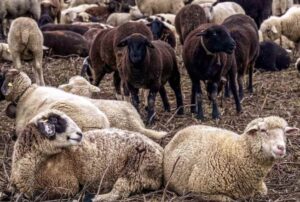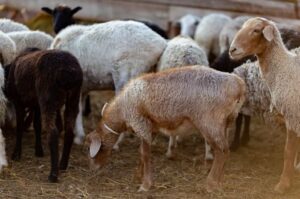Sheep Farming: In sheep farming, the feed conversion ratio (FCR) is a crucial indicator of the effectiveness of animal output. It aids farmers in understanding how efficiently their livestock transform feed into marketable milk or meat. A low FCR means that the animals are not receiving enough nutrients from their food, while a high FCR shows that the animals are using their feed effectively.

Important guidelines to enhance sheep’s feed conversion ratio (FCR)
Why is raising FCR crucial for livestock farming?
It can help to improve the overall profitability of the business. By requiring less feed for each animal, it can also increase the sustainability of the herd. Reduced incidence of issues like obesity and digestive difficulties can be a result of improved FCR, which can also contribute to improved animal welfare. The most apparent advantage, though, is that it might result in higher profits.
This is so that more of the feed consumed by the sheep’s is converted into meat, wool, or milk, which can be sold for a profit. FCRs that are greater are indicative of this. Additionally, higher FCR can result in animals that are heavier and healthy as well as more successful pregnancies. Therefore, any sheep farmer seeking to increase their operation’s productivity and profitability should make improving FCR a top priority.
FCR importance in sheep farming
- It contributes to ensuring that the sheep receive the right nutrients for growth and well-being. Additionally, it lowers the quantity of feed required to create a given amount of meat or wool, which helps to keep costs low.
- By lowering the prevalence of illness and fostering growth and development, it can aid in enhancing the flock’s general quality.
- As one of the biggest expenditures in sheep farming, feed costs are reduced by a higher FCR, which boosts profitability.
- Good animal husbandry techniques lead to healthier, more fruitful animals, which are indicated by a high FCR.
- A higher FCR is also a sign of the animals’ excellent genetic merit, which over time results in better-quality progeny and increased flock productivity.
A high FCR suggests effective feed utilization, which lowers output costs and boosts profits. A low FCR, on the other hand, denotes inefficient feed use, which raises production expenses and reduces profits. - While a low FCR results in higher production costs and fewer profits, a high FCR results in lower production costs and higher profits.
- Sheep farming is a major contributor to greenhouse gas emissions due in part to the methane produced by sheep during digestion. On the other hand, methane emissions are decreased and sheep farming activities become more sustainable when feed is used more effectively (higher FCR).
- Animals that are malnourished or suffer from health issues as a result of poor diets can be found on poorly run sheep ranches with low FCRS. Animals are fed properly and are kept in good health thanks to good management techniques that result in high FCRS
Management strategies for improving FCR
The primary concern is ensuring that the sheep have access to nutritious food. To do this, choose food sources rich in crude protein and easily absorbed energy. The sheep will be able to keep a good body condition score with the aid of high-quality forage, which also encourages effective digestion and nutrient absorption.
Making ensuring the sheep are properly fed is a crucial management strategy. This entails offering them a well-balanced meal that satisfies their nutrient and energy needs. Underfeeding will result in poor body condition and decreased wool output, whereas overfeeding can cause excessive body fat deposition and decreased feed effectiveness. Offering the different sheep feeds will encourage them to consume more and will increase digestibility.
The importance of concentrating on giving the livestock a high-quality diet cannot be overstated. This entails making certain they have access to a lot of lush, green pasture and a nutritious diet that includes a mix of hay, grain, and other foods. Keeping the sheep healthy and reducing tension is another crucial tactic. This includes giving them access to sanitary facilities, safe housing, and protection from illness and parasites.
It is also critical to keep a close eye on the sheep’s nutrition and development so that any issues can be swiftly found and resolved. All of these actions will enable sheep farming enterprises to increase FCR. Finally, it is critical to keep a close eye out for disease or parasite signs in the flock because they can have a negative impact on feed conversion efficiency. To reduce these risks, routine deworming and vaccination programs should be adopted.
How to calculate FCR in sheep framing?
- Calculating the daily dry matter intake for your sheep is the first stage. (DMI). To do this, divide the entire amount of feed that each sheep in the flock consumes each day by the number of sheep.
- The average live weight (ALW) of your herd should then be determined. The weight of the entire flock of sheep is calculated by dividing its overall weight by the number of sheep.
- Finally, divide the DMI by the ALW to obtain the FCR. For instance, the FCR would be 10/50 = 0.2 if the DMI was 10 kg and the ALW was 50 kg.
- You can swiftly and simply calculate the FCR of your flock using these straightforward calculations. As a result, raising your flock’s FCR will help it be healthier and more productive as a whole.

Steps to improve FCR in sheep farming
- Good nourishment is crucial, so care must be taken to consider the nutritional value of any supplemental feeds as well as the quality of the pasture and hay.
- As bodyweight directly influences FCR, it should be watched and kept at a healthy level. Lambs should be weaned as soon as feasible to start digesting solid food and lessen their reliance on milk. Last but not least, keeping sheep in top condition and increasing their overall FCR will be made possible by routine health examinations and quick treatment of any health issues that emerge.
- The health and age of the sheep is another important element that significantly affects FCR. Sheep that are younger and healthier have greater metabolisms and can convert food into body mass more effectively than sheep that are older or sicker. They will therefore have a higher FCR independent of the feed they consume.
- Finally, managerial techniques can have an impact on FCR. For instance, if sheep are crowded, they might fight over food and eat insufficiently, which would result in lower weight growth and a worse FCR. Similar to this, lower FCR can result from stressed livestock brought on by subpar husbandry techniques.
Key points to increase FCR in sheep farming
Select the right genetic stock: Genetics is one of the most significant variables affecting FCR. Choosing the appropriate genetic stock for your property is therefore essential. When making choices, be sure to seek the advice of experts and use information from reputable sources.
Focus on nutrition: Nutrition also has a significant impact on FCR. Working with a skilled nutritionist will ensure that your sheep receive the proper balance of nutrients. You must ensure that your livestock are properly nourished. This entails providing them a balanced diet and clean water.
Create a healthy environment: The third significant element affecting FCR is the environment. It will be easier for your sheep to remain healthy and perform at their best if you provide them with a clean, stress-free environment.
How is Mexican sheep farming profitable?
Sheep herding is a very lucrative agricultural industry in Mexico. The primary cause is the substantial domestic and international demand for lamb. Additionally, Mexican lambs generate a lot of milk and meat, making them well-suited for export. Selling their wool is an excellent way for farmers to supplement their income.
Types of Sheep Farming in Mexico
Free range: The sheep are allowed to roam outdoors freely in this kind of sheep farming, where they can access fresh water and a range of natural feed sources. This kind of farming, however, is more challenging to run because it necessitates continuous watchfulness on the farmer’s part to make sure that the sheep are not lost or tramped upon.
Pasture-based: The sheep are maintained on expansive fields in this type of farming so they can graze on hay and other pasture-based feed. The farmer only needs to keep an eye out for overgrazing and occasionally adjust the grazing schedule, making this method simpler to manage than free-range farming.
Sheep barn: The sheep are confined indoors in pens while being sheared on a farm built in the Sheep Barn style. (or have their wool trimmed). Since there is no need for hay storage or delivery, this method is more effective than pasture-based systems. However, the farmer must take more caution with it. (who must monitor the temperature, ventilation, and enclosure conditions).

Mexico Sheep Farming Loans and Subsidies
- The Mexican government has created a number of initiatives to advance sheep herding there. These programs include financing equipment acquisitions, assisting farmers with land investments, and creating product distribution channels.
- Recent loans and subsidies from the Mexican government have been given to farmers to help them establish and expand sheep farms. The demand for sheep meat is strong in Mexico because a significant portion of the population has an allergy to wool products.
- The government offers fixed-interest loans to farms, which can be repaid over time with interest. Additionally, the government gives the farm compensation for every lamb it produces. These payments may amount to as much as 30% of the cost of the meat. This makes beginning and expanding a sheep farm more affordable and motivates farmers to raise more lambs than they otherwise would if they were raising them for the purpose of selling meat.
- The number of sheep farms in Mexico is already in the thousands, and the business is expanding quickly.
Sheep Farming Challenges in Mexico
1. The first difficulty is getting to pastureland. In Mexico, large estates or governmental organizations own the majority of the property used for grazing. As a result, farmers are unable to raise sheep on a large basis.
2. The second problem is a lack of water. Water is essential to shepherds for drinking, washing their livestock, and irrigating their crops. Due to this, many Mexican farms have had to come up with creative methods for gathering rainwater and using it for irrigation.
3. The third issue is parasites and illnesses. Shepherds must avoid spreading diseases to the flock because they depend on their livestock for food and money. Because they can result in substantial losses in the populations of livestock, parasites can also be a significant issue for sheep farmers.
4. Finding sufficient feed to satisfy domestic and international market demand is the next challenge confronting Mexican sheep farmers. Increased funding for agricultural production centers and improved accessibility to transportation networks will be necessary to meet this challenge.

Conclusion
In Mexico, raising sheep has been a way of life for generations. Sheep are adaptable creatures that can produce both fleece and meat. They also offer farmers a valuable form of income and are generally simple to maintain. A company that breeds sheep is called a sheep farm. A barn, pastures, and feeders are among the extensive equipment and land requirements. Additionally, the company requires a supply of fresh water for the livestock.


